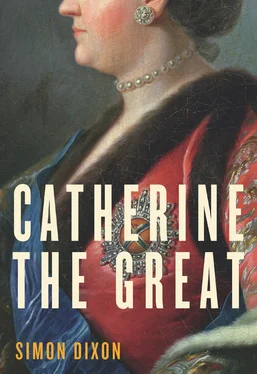* * *
Instead, the new tsar, Alexander I, promised in his accession manifesto that he would rule according to his grandmother’s ‘heart and laws’. 19Delighted by the prospect, Princess Dashkova anticipated an opportunity to bask in Catherine’s reflected glory. Although their tempestuous relationship had ended in tears—as early as 1792, John Parkinson found that ‘her conversation evidently savoured of disaffection to the empress’—the princess was never less than effusive after Catherine’s death, relishing the opportunity to regale visitors such as Martha and Catherine Wilmot with tales of ‘the wonderful scenes of the revolution in which she acted so wonderful a part at the age of 18’. 20Noting that Dashkova always pronounced Catherine’s name ‘with rapture’, one of her Russian acquaintances suggested that her oratory was so mesmerising that her ‘audience unwittingly submitted to her attractive eloquence’. 21That was stretching the truth. Catherine Wilmot felt uncomfortable in the face of the princess’s stories: ‘These subjects as ripping up a life that is almost past gives [ sic ] a powerful sort of agitated animation to her Countenance, & I long till it is over.’ 22But Dashkova was undeterred. Apparently oblivious to such reactions, she sought a wider readership by sending anecdotes about Catherine to the new journals that sprang up under Alexander I, and in 1806 published a volume of anecdotes of her own, praising the empress’s ‘most kind and affectionate love for humanity, a love that rarely dwells in the hearts of rulers’. 23
Nor was the princess alone in seeking to publicise her heroine’s glorious achievements. Documents about Catherine accounted for almost four-fifths of the historical material published in Russian journals in the first five years of the nineteenth century. 24Within months of Alexander’s accession, Catherine’s own historical works had been republished alongside a translation of her correspondence with Dr Zimmerman. Editions of some of her plays and multiple Russian versions of her correspondence with Voltaire and Field Marshal Rumyantsev soon followed. 25As a bandwagon of publications in praise of the late empress began to roll, Nikolay Karamzin set the tone in 1802 with a paean of praise eulogising the formative role of the ruler in Russian history. 26Sponsored by seventy subscribers, including Maria Perekusikhina and Metropolitan Amvrosy, Peter Kolotov published a six-volume chronology of Catherine’s reign in 1811, drawing on material he had been collecting for the past twenty years. 27Three years later, Ivan Sreznevsky published a collection of short anecdotes declaring it ‘desirable that all the works of the Great Catherine, having glorified and magnified Russia, should be made known to everyone’. 28
‘Every circumstance attending Katherine’s Time begins to bear a sacred stamp already,’ noted Martha Wilmot following a visit to Tsarskoye Selo in 1808: ‘The grounds are not remarkable for beauty nor the Contrary; they interest one as being often walk’d by Katherine.’ 29Nor was it only at Tsarskoye Selo that Catherine had left her indelible imprint. ‘Without Catherine,’ one memoirist claimed, St Petersburg ‘would soon have sunk back into the bog from which it emerged’. 30The capital, however, was Peter the Great’s shrine. To reach a territory that was distinctively Catherine’s, it was necessary to radiate outwards to Tver, where the triumphal gates marking the empress’s visit in 1767 still stood, or to that other favourite city of hers, Kazan, where Peter Sumarokov ‘bowed his head with heartfelt feeling’ to the berth in Catherine’s cabin on her galley in 1838. 31
Among the military men who proved especially susceptible to the mixture of nostalgia and self-importance that characterised Catherine’s posthumous admirers, none was more gallant than Denis Davydov, hero of 1812 and hero-worshipper of Field Marshal Suvorov. Horrified that ‘the immortal Catherine’ should be subjected to ‘lampoons about her private life’, Davydov praised her reign in 1831 as ‘most brilliant, most triumphant’, and no less useful to Russia than that of Peter the Great. Many fellow veterans shared in his veneration of Catherine’s ‘miraculous age’. 32It was partly among such circles of ‘old people, officers of the Guards in Catherine’s time’ that the young Alexander Herzen grew up in Moscow in the 1830s. 33For all their importance as mythmakers, however, soldiers were ultimately outranked by salon hostesses. Though Alexandra Branicka, Potëmkin’s eldest niece and one of Catherine’s closest friends, remained closeted on her husband’s estate at Belaya Tserkov, there was no shortage of female relics of Catherine’s reign who continued to proclaim it as their finest hour. Catherine’s last maid of honour, Praskovia Myatleva (née Saltykova), lived until 1859, when the cream of Petersburg society processed down Nevsky Prospect behind her catafalque. 34The most flamboyant was Platon Zubov’s elder sister, Olga Zherebtsova, who became a legend in her own right as a former lover of the British ambassador Charles Whitworth, an alleged lynchpin in the conspiracy to assassinate Tsar Paul. Steeped as deeply as her heroine in the works of the French philosophes , Zherebtsova struck Herzen, who met her in her seventies, as ‘a strange, eccentric ruin of another age, surrounded by degenerate successors that had sprung up on the mean and barren soil of Petersburg court life.’ 35But she was far from the only Russian noblewoman to delight in reminiscing about her gilded youth in the shadow of the empress. Alexandra Shishkova hung a full-length portrait of Catherine in her bedroom alongside another of Christ and was said never to wear any other blouse than those she had purchased from the empress’s wardrobe. Maria Kikina, daughter of a leading Court official, also preserved her sitting room as a shrine to Catherine. 36
Even a chance encounter with the empress was enough to infuse a lasting glow in those who outlived her. Yet the sense that hers had been a golden age was by no means confined to subjects who were prominent enough to revel in the memory of personal contact. On the contrary, these few members of the elite merely personified the strong tide of popular sentiment that swelled demand for Nikolay Utkin’s engraving of Borovikovsky’s Lady with a dog , commissioned in 1826 by Count Nikolay Rumyantsev and printed in the following year. 37A whole generation of Russians grew up, like the writer Apollon Grigoryev, at the feet of grandfathers who reminisced about Catherine and her times as the smoke from their pipes curled into the night. 38Many, it seemed, still succumbed to the mood of nostalgia which engulfed the ‘babbling old Widow’ the Wilmot sisters met at Tsarskoye Selo in 1808, ‘who has been talking of the days that were pass’d till she was obliged to wipe her eyes in the sleeve of her gown’. 39
While the modern eye might not detect anything sinister in any of this, the tsar was understandably wary of attempts to veil intemperate demands on his own regime under praise for aspects of Catherine’s, and he could hardly have been expected to approve of attempts to manipulate the past as a means of reproaching the present. ‘Happily for us,’ wrote a canny contributor to Karamzin’s Messenger of Europe in 1804, ‘everything demonstrates the particular resemblance in heart and soul between Alexander and Catherine—favourite grandson of his adored grandmother.’ 40Writers were particularly keen to urge the tsar to reject his father’s philistinism and return to the more tolerant atmosphere of the 1760s and 1770s. Before the reign of Alexander II in the mid-nineteenth century, no one paid much attention to Catherine’s own literary achievements. The point was that by joining the ranks of the writers, she had radically improved the status of their emergent profession. Without the empress’s personal interest and protection, the argument ran, there would have been no Fonvizin, no Derzhavin, and none of the other ‘immortal’ literary figures who emerged in her reign. 41‘Talents perish like spring flowers from stormy winds and frost,’ warned Nikolay Grech in a lecture at the Imperial Public Library in 1817, ‘but in Russia there are no such obstacles…Catherine gave her subjects the freedom to express their thoughts freely both in print and in speech.’ 42Catherine had loved scholarship for scholarship’s sake, Grech told readers of his history of Russian literature. Others took up the refrain. ‘Here, at every step,’ wrote Konstantin Batyushkov of the Academy of Sciences, ‘the enlightened patriot should bless the memory of the monarch who deserves to be called “great and wise” by posterity not so much on account of her victories as for the useful institutions’ she established. 43It was impossible not to notice the veiled criticism of the tsar who had conquered Napoleon. In his speech to the Russian Academy in 1818, Karamzin offered another tactful reminder to Alexander that Catherine had loved ‘both the glory of victory and the glory of reason’, accepting ‘this happy fruit of the Academy’s work with the same flattering favour with which she succeeded in rewarding everything praiseworthy and which she bequeathed to you, gracious Tsar, as an unforgettable, precious memory’. 44The note of reproach sounded rather more obviously in the Decembrist journal Polar Star , which looked back on Catherine’s reign in 1823 as a ‘golden age for literary scholars’: ‘All our best writers arose or were educated under her dominion.’ 45‘The Age of Catherine is the age of encouragement,’ Pushkin remarked in 1825. ‘In that respect it is no worse than any others.’ 46In private, scholars were more openly critical. Already in 1810, the American ambassador John Quincy Adams met an official at the Academy of Sciences who complained ‘of the neglect of the sciences in the present day. The Age of Catherine is past.’ 47
Читать дальше












